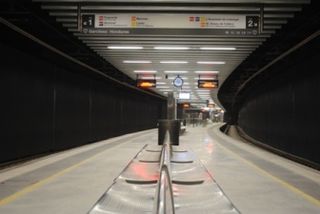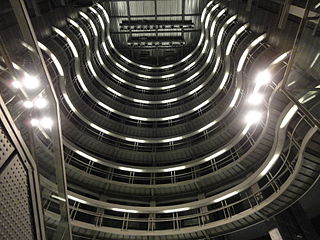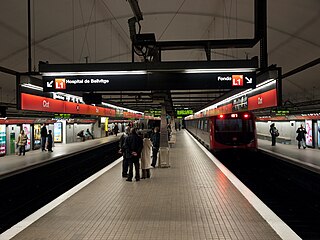
Trambesòs is a tram–light rail system in the Spanish autonomous community of Catalonia that links the Barcelona district of Sant Martí with Badalona and Sant Adrià de Besòs. Its name comes from the union of the words "tram", an abbreviation of the Catalan word for "tram" (tramvia), and "Besòs", the name of an area in the north of the Barcelonès region dominated by the Besòs River.

Line 4, also known as Trinitat Nova – La Pau, usually called "línia groga", is a line in the Barcelona Metro network operated by TMB, and part of the ATM fare-integrated transport network. It serves the northern districts of the city, and it is being extended to the new major metro and rail stations Estació de la Sagrera and Sagrera-Meridiana.
— Line 8, coloured pink and operated by FGC, is part of the Barcelona Metro network, and therefore of the larger ATM fare-integrated transport system. It joins Plaça Espanya, in the Sants-Montjuïc district of Barcelona with metropolitan area municipalities of L'Hospitalet de Llobregat, Cornellà de Llobregat and Sant Boi de Llobregat.

Avinguda Diagonal is the name of one of Barcelona's broadest and most important avenues. It cuts the city in two, diagonally with respect to the grid pattern of the surrounding streets, hence the name.

Universitat is a Barcelona Metro station named after Plaça de la Universitat, split between Eixample and Ciutat Vella districts of Barcelona, where the station is located in. This square holds the historical building of Universitat de Barcelona, celebrated for its neo-gothic style. The station is accessible for disabled persons since 1995, when Barcelona Metro line 2 opened its platforms. It is served by TMB-operated Barcelona Metro lines L1 and L2.

Marina is a station in the Barcelona Metro and Trambesòs tram networks, at the boundary between the Eixample and Sant Martí districts of Barcelona. It is served by TMB line L1 and tram route T4. The station is named after the nearby Carrer de la Marina, and can be accessed from Carrer dels Almogàvers, and the crossing of Carrer de la Marina with the Avinguda Meridiana. It is adapted for disabled people.

La Sagrera-Meridiana, simply known as La Sagrera, is an interchange complex underneath Avinguda Meridiana, in the Barcelona district of Sant Andreu, in Catalonia, Spain. It consists of a Rodalies de Catalunya station and three Barcelona Metro stations. The Rodalies de Catalunya station is located in the Meridiana Tunnel on the Lleida to Barcelona via Manresa railway, between Sant Andreu Arenal and Arc de Triomf, and is operated by Renfe Operadora. It is served by Barcelona commuter rail service lines R3 and R4, as well as regional rail line R12. The Barcelona Metro stations are on lines 1 (L1) and 5 (L5), as well as the northern section of line 9/10, and are operated by Transports Metropolitans de Barcelona (TMB). On the L1, the station is between Navas and Fabra i Puig, on the L5 between Camp de l'Arpa and Congrés, and on the L9/L10 between Plaça Maragall (future) and Sagrera - TAV. The station is also projected to become the terminus of the L4 once the extension from La Pau opens. A number of interurban bus services stop near the station.

Ildefons Cerdà is a railway station on the Llobregat–Anoia Line. It is not properly located in Plaça d'Ildefons Cerdà, but in the L'Hospitalet de Llobregat municipality, in Catalonia, Spain. The station is situated underneath Gran Via de les Corts Catalanes and was opened in 1987. It is served by Barcelona Metro line 8, Baix Llobregat Metro lines S3, S4 and S8, S9, and commuter rail lines R5, R6, R50 and R60.

Line 10 is the name of one of the two branches of the Barcelona metro line 9, currently (2020) under construction and to be operated by TMB. Like Line 9 and Line 11, it will be an automatic train operation metro line.

Jaume I is a station in the Barcelona Metro network, located under Via Laietana, an important avenue in Ciutat Vella, right between Plaça de Ramon Berenguer el Gran and Plaça d'Emili Vilanova. It can be accessed from Plaça de l'Àngel and Carrer d'Argenteria, on the other side of Via Laietana.

Liceu is a Barcelona Metro station situated under the La Rambla between Gran Teatre del Liceu and Mercat de la Boqueria in the Barri Gòtic, part of Barcelona's district of Ciutat Vella. It is served by TMB-operated Barcelona Metro line L3.

Torre Baró | Vallbona is a station on line 11 of the Barcelona Metro, serving the neighbourhoods Torre Baró and Vallbona of the Nou Barris district of Barcelona.

El Clot is a station serving line 1 and line 2 of the Barcelona Metro.

La Rambla | Drassanes is a Barcelona Metro station located underneath Portal de la Santa Madrona, just off La Rambla in the Ciutat Vella district of Barcelona. It is named after the nearby Drassanes Reials de Barcelona, the old shipyards that are now the home of the Museu Marítim de Barcelona. It is the closest station to the Port of Barcelona and one of the network's closest stations to the sea, and is served by TMB-operated Barcelona Metro line L3.

Navas is a Barcelona Metro station located in the Sant Andreu district of Barcelona, served by L1. It opened in 1953. The name refers to carrer Navas de Tolosa, and the station was originally called Navas de Tolosa until it adopted its current name in 1982.

Carrer d'Aragó is a major thoroughfare in Barcelona, one of the widest and busiest roads of the districts it cuts through, especially Eixample but also Sant Martí. Its creation was passed in 1863, and was part of Ildefons Cerdà's urban plan, appearing as L Street in 1867, even though that name was never approved. Instead, another name, a reference to the Crown of Aragon, was proposed in 1863 by Víctor Balaguer, who was commissioned by the city council to rename all the streets in the area. Its Spanish-language rendition, Calle de Aragón, was the official designation back then. It starts in Carrer de Tarragona and it becomes Rambla de Guipúscoa at the intersection with Carrer de Lope de Vega.

Ciutat Meridiana is a neighborhood in the Nou Barris district of Barcelona, Catalonia (Spain).



















